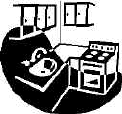Green Building
Indoor Environmental Quality
In many homes, the indoor air is often more polluted than the outdoor air. Radon, tobacco smoke, gases released from fireplaces and gas stoves, molds caused by dust build-up and excess moisture, and chemicals used in building materials and household products all can contribute to poor air quality and feeling ill. Building materials can release chemicals known as volatile organic compounds (VOCs) into the air. This process is known as off-gassing. VOCs evaporate into the air and react with sunlight to form ground-level ozone. VOCs include carcinogens, endocrine disrupters, central nervous system disrupters, and sensitizers. Biological contaminants and off-gassing can cause common symptoms such as headaches, fatigue, eye and throat irritation, and respiratory diseases.
If you are planning a remodeling project or constructing a new home, here a few pollution prevention strategies to consider that will improve indoor air quality when working with a contractor or doing the work yourself:

Avoid or minimize carpet use
Avoid the use of wall to wall carpets. Carpeting can harbor biological contaminants such as mold and mildew, dust mites, animal dander, bacteria, pollen, and viruses. Other potential sources of pollution include the chemical fumes from the synthetic fibers, backing, padding, cleaners, and adhesives and glues used to install carpeting. Many natural wool carpets have been pretreated with powerful chemical moth deterrents. Studies have been shown that carpets can become contaminated with lead and pesticides that are carried into the house on shoes.
The best solution is to use area rugs made from cotton which are easy to clean. Throw rugs can be used in combination with flooring made from other materials such as wood, ceramic tiles, cork, linoleum, and stone. Floors made from natural materials are durable and easy to maintain.

Use interior paints, paint strippers and thinners, and wood finishes that contain low or no volatile organic compounds (VOCs)
VOCs contribute to smog and indoor air pollution. Oil-based paints have higher levels of VOCs than water-based latex paints. Water-based latex paints typically contain formaldehyde used as a preservative. Glossy paints are higher in VOCs than flat paints. Search for paint brands, such as Sherwin-Williams, Glidden (Spred 2000 paints), and Benjamin Moore which offer paints with low or no VOCs. The long-time, most popular paint used by people with chemical sensitivities has been the whole line of paints manufactured by AFM Enterprises in San Diego. They are not sold in stores, but can by ordered by calling (619) 239-0321. This company also carries carpeting, flooring, paints and finishes, and wallpaper. A catalog is available. There are distributors in the east that carry their products.
Read the label of your paint, strippers, thinners, and finishes for VOCs such as petroleum distillates, mineral spirits , chlorinated solvents, methylene chloride, trichloroethylene, and trichloroethane. The safest paint stripper is a thick washing soda and water paste. Be sure to wear gloves. Otherwise, choose the water-based stripper Safest Stripper, available in hardware and lumber supply stores. Avoid methyl chloride which is a carcinogen. Always use any of these products in well ventilated areas.
Specify nontoxic finishes for wood floors
Avoid using an oil-based urethane finish. There are many water-based and non-solvent based finishes available. If installing new hardwood floors, consider buying pre-finished boards or using one of the low-toxic finishes available from stores like the Environmental Home Center, Seattle, WA (800) 281-9785. Water-based and non-solvent based finishes are preferable and available. Work with an installer who is familiar with these products. Also, by laying a conventional hardwood floor strip and hammering the nails diagonally in the groove of the tongue-and-groove wood, you can avoid the need for toxic solvent-based wood filler.

Avoid cabinets, doors, wall paneling, furniture, kitchen counters and other interior items that contain conventional, engineered wood products
Engineered wood is manufactured by gluing layers or fragments of wood together. Products made from this material contain bonding agents and adhesives that can emit unhealthy pollutants such as formaldehyde. Choose solid wood or engineered wood products that contain few or no toxic chemicals.
Use natural alternatives to synthetic cleaning compounds. Household cleaners can contribute greatly to poor indoor air quality. For instance, most household bleach is sodium hypochlorite, a moderately toxic chlorine salt. Chlorine bleach is dangerous when combined with ammonia or acids such as vinegar, because toxic gases are released. Ammonia should also be avoided because of its toxicity. It is also corrosive, explosive, and can cause chronic inflammation.
Refer to the following chart when purchasing cleaning products:

| No signal word | Not hazardous |
| Caution | Mild/moderate hazard |
| Warning | Moderate hazard |
| Danger | Extremely flammable, corrosive or Highly toxic. |
| Poison | Highly toxic |
As an alternative, try using baking soda as a mild scouring powder or, make an all purpose soap and vinegar cleaner by mixing ¼ cup liquid soap or detergent, ½ cup white distilled vinegar, and 2 gallons water.
Additional Sources of Information
- The Environmental Building News
- Oikos/Green Construction Source
- U.S. Green Building Council
- The Green Building Source Book
Books
- Better Basics for the Home, Simple Solutions for Less Toxic Living, Annie Bertold-Bond, Three Rivers Press, NY, 1999, ISBN #0-609-80325-5
- Home Safe Home, Protecting Yourself and Your Family from Everyday Toxics and Harmful Household Products, Debra Lynn Dadd, Penguin Putnam, Inc, NY, 1997, ISBN# 0-87477-859-X
This information is provided as a service to those professionals in the construction industry. This information does not include all available references and does not constitute an endorsement by DEEP. Use of this information does not in any way lessen your responsibilities for compliance with applicable federal, state, and local laws.
Green Building
Content Last Updated February 2020

